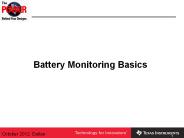Part B1: Basics - PowerPoint PPT Presentation
1 / 50
Title:
Part B1: Basics
Description:
Part B1: Basics B1.3 Water conveyance B1.3 Water conveyance Topics Inlet arrangements Diversion structures, settling, dealing with flood Water transport Limitations ... – PowerPoint PPT presentation
Number of Views:128
Avg rating:3.0/5.0
Title: Part B1: Basics
1
Part B1 Basics B1.3 Water conveyance
2
B1.3 Water conveyanceTopics
- Inlet arrangements
- Diversion structures, settling, dealing with
flood - Water transport
- Limitations of canals
- Getting around obstacles
- Flumes, culverts, syphons, Inverted syphons,
3
B1.3 Water conveyanceConveyance arrangements
4
B1.3.1 Water conveyance Inlet arrangements
Considerations
- How much of the flow to divert
- Total flow needs weirs which are expensive and
may cause problems - Some fraction may be cheaper
- Dealing with abnormal flow
- Drought (low flow) lack of performance (may
not work at all) - Flood (high flow) things break!!!!
- Dealing with sediment
- Blocking of the inlet
5
B1.3.1 Water conveyance Water transport
Intakes siting
6
B1.3.1 Water conveyance Water transport
Intakes siting
7
B1.3.1 Water conveyance Water transport
Intakes siting
8
B1.3.1 Water conveyance Water transport Intakes
Direct Inlet
Side Inlet
9
B1.3.1 Water conveyance Water transport
IntakesGabions
10
B1.3.1 Water conveyance Water transport
Intakes Direct inlet
11
B1.3.1 Water conveyance Water transport
Intakes Side inlet
12
B1.3.1 Water conveyance Water transport
Intakes Pros and cons
Direct Side
Better transport of silt into the headrace More difficult to construct Needs special grill to self clean Easier to construct Self cleaning
13
B1.3.1 Water conveyance Water transport
Intakes Grilles
Sloped grille for direct inlet
Plain grille for side inlet
14
B1.3.1 Water conveyance Water transport
Intakes Stream bed
15
B1.3.3 Water conveyance Water transport
Intakes Rate of inlet
over-top
weir crest
Normal water level (hr)
Headrace water level (hh)
Intake area (A)
From Bernoulli
Cd 0.6-0.8
16
B1.3.3 Water conveyance Water transport
Intakes Rate of inlet
over-top
weir crest
17
B1.3.3 Water conveyance Water transport
Intakes Rate of inlet Weir coefficients
Shape coefficient
Broad sharp edges 1.5
Broad round edges 1.6
rounded 2.1
Sharp 1.9
Roof shaped 2.3
18
B1.3.1 Water conveyance Water transport
Intakes Spillway
19
B1.3.1 Water conveyance Water transport
Intakes Spillway
20
B1.3.1 Water conveyance Water transport
Intakes Settlement
21
B1.3.1 Water conveyance Water transport
Intakes Settlement
22
B1.3.2 Water conveyance Water transport Open
channels Manning's equation
V Stream velocity (m s-1) R Hydraulic
radius S Slope n Manning roughness
23
B1.3.2 Water conveyance Water transport
Hydraulic radius producing the ideal cross
section
Shape Efficiency
Semi circular 1
Half hexagon 0.95
Vee 0.89
Half square 0.84
24
B1.3.2 Water conveyance Water transport the
ideal cross section and variable flow
25
B1.3.2 Water conveyance Water transport Shapes
for highly variable flow
26
B1.3.2 Water conveyance Water transport Soil
and side slopes
Soil type Slope Slope
Sandy loam 2
Loam 1.5
Clay loam 1
Clay 0.58
Concrete 0.58
27
B1.3.2 Water conveyance Water transport
Limitations to velocity
- To high channel erosion
- To low - silting
28
B1.3.2 Water conveyance Water transport Maximum
and minimum speeds
Maximum speeds Clear Sedimented
Fine sand 0.45 0.45
Silt loam 0.60 0.60
Fine gravel 0.75 1.00
Stiff clay 1.2 0.90
Coarse gravel 1.2 1.8
Shale, hardpan 1.8 1.5
Steel - 2.4
Timber 6.0 3.0
concrete 12.0 3.6
Minimum speeds 0.1 0.31
29
B1.3.2 Water conveyance Water transport getting
it wrong
30
B1.3.2 Water conveyance Water transport grass
in channels
31
B1.3.2 Water conveyance Water transport grass
in channels
Maximum speeds (m/s) Bare Medium grass cover Very good grass cover
Very light silty sand 0.3 0.75 1.5
Light loose sand 0.5 0.9 1.5
Coarse sand 0.75 1.25 1.7
Sandy loam 0.75 1.5 2.0
Sandy soil 1.0 1.7 2.3
Firm clay loam 1.5 1.8 2.3
Stiff clay or stiff gravelly soil 1.5 1.8 Unlikely to form
Course gravel 1.8 2.1 Unlikely to form
32
B1.3.2 Water conveyance Water transport High
slopes Hydraulic jump
33
B1.3.2 Water conveyance Water transport High
slopes Hydraulic jump Critical depth
A Cross sectional area (m) B breadth of
stream at the surface (m)
34
B1.3.2 Water conveyance Water transport High
slopes Steps
35
B1.3.2 Water conveyance Water transport High
slopes Steps
36
B1.3.2 Water conveyance Water transport making
channels
37
B1.3.2 Water conveyance Water transport making
channels
38
B1.3.2 Water conveyance Water transport making
channels
39
B1.3.3 Water conveyance Obstacles Flume
40
B1.3.3 Water conveyance Obstacles Flume
41
B1.3.3 Water conveyance Obstacles Pipe bridge
42
B1.3.3 Water conveyance Obstacles Pipe bridge
43
B1.3.3 Water conveyance Obstacles part full
pipes
44
B1.3.3 Water conveyance Obstacles Culverts
45
B1.3.3 Water conveyance Obstacles Culverts
46
B1.3.3 Water conveyance Obstacles Inverted
syphons
47
B1.3.3 Water conveyance Obstacles Inverted
syphons
48
B1.3.4 Water conveyance Comparison between
closed pipes and open channels
Open channels Closed pipes
Susceptible to blocking Water protected from outside factors
Needs care with manipulating gradients to stay within limits Constant flow rate easy to maintain Variable gradient permissible
Cheap to build Expensive to build
Cheap to maintain Expensive to maintain blockages are hidden and difficult to remove Air locks
49
B1.3 Water conveyance Summary
- Intakes should be carefully sited to avoid
silting or damage. They should also be
self-cleaning - Water conveyance structures should be designed
for both high and low flow conditions. A number
of methods are available to do this such as
weirs, spillways and sluice gates - The height of the flow is predictable using
Bernoulli and manning formulas - Channel cross sections should take account
limitations placed by the soil. Stepping the
channels can be used to slow the flow and avoid
hydraulic jump - A number of methods can be used to overcome
obstacles such as flumes, pipes bridges, culverts
and inverted syphons
50
B2.1 Next..Hydro power































